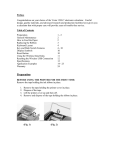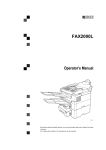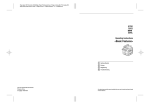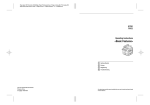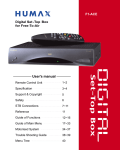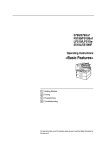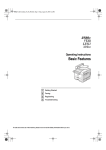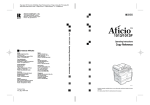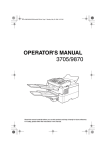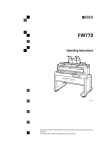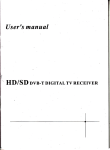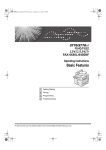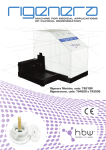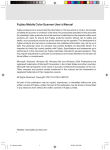Download Ricoh FAX1400L User's Manual
Transcript
Cover1-1 Page 1 Friday, October 27, 2000 8:42 PM
FAX1400L
Operating Instructions
<Basic Features>
Read this manual carefully before you use this product and keep it handy for future
reference.
For safety, please follow the instructions in this manual.
Holsten1AE_Basic_FM.book Page 1 Thursday, October 26, 2000 3:55 PM
Introduction
This manual contains detailed instructions on the operation and maintenance of this machine. To get
maximum versatility from this machine all operators should carefully read and follow the instructions in
this manual. Please keep this manual in a handy place near the machine.
Please read the Safety Information in the Advanced Features manual before using this machine. It contains important information related to USER SAFETY and PREVENTING EQUIPMENT PROBLEMS.
Notes:
Some illustrations might be slightly different from your machine.
Certain options might not be available in some countries. For details, please contact your local dealer.
Laser Safety:
Direct (or indirect reflected) eye contact with the laser beam may cause serious eye damage. Safety
precautions and interlock mechanisms have been designed to prevent any possible laser beam exposure to the operator.
Warning:
Use of controls or adjustment or performance of procedures other than those specified in this manual
might result in hazardous radiation exposure.
Two kinds of size notation are employed in this manual. With this machine refer to the metric version.
For good copy quality, Ricoh recommends that you use genuine Ricoh toner.
Ricoh shall not be responsible for any damage or expense that might result from the use of parts other
than genuine Ricoh parts in your Ricoh office product.
Important
Parts of this manual are subject to change without prior notice. In no event will the company be liable
for direct, indirect, special, incidental, or consequential damages as a result of handling or operating
the machine.
Power Source:
AC220–240V, 50/60Hz
Please be sure to connect the power cord to a power source as above. For details about power source,
see Chapter 10, “Connecting the Power and Switching On” in the Advanced Features manual.
Holsten1AE_Basic_FM.book Page i Monday, November 6, 2000 8:10 PM
How to Read This Manual
Symbols
In this manual, the following symbols are used:
R WARNING:
This symbol indicates a potentially hazardous situation that might result in
death or serious injury when you misuse the machine without following the instructions under this symbol. Be sure to read the instructions, all of which are described in the Safety Information section in the Advanced Features manual.
R CAUTION:
This symbol indicates a potentially hazardous situation that might result in minor or moderate injury or property damage that does not involve personal injury
when you misuse the machine without following the instructions under this
symbol. Be sure to read the instructions, all of which are described in the Safety
Information section in the Advanced Features manual.
* The statements above are notes for your safety.
Important
If this instruction is not followed, paper might be misfed, originals might be
damaged, or data might be lost. Be sure to read this.
Preparation
This symbol indicates the prior knowledge or preparations required before operating.
Note
This symbol indicates precautions for operation, or actions to take after misoperation.
Limitation
This symbol indicates numerical limits, functions that cannot be used together,
or conditions in which a particular function cannot be used.
Reference
This symbol indicates a reference.
{
}
Keys built into the machine's operation panel.
i
Holsten1AE_Basic_FM.book Page ii Monday, November 6, 2000 8:10 PM
TABLE OF CONTENTS
Manuals for this machine ......................................................................... 1
Basic Features (This Manual) ....................................................................... 1
Advanced Features ....................................................................................... 1
1. Introduction
Part Names.................................................................................................
Front View .....................................................................................................
Rear View......................................................................................................
Operation Panel .........................................................................................
3
3
4
5
Symbols and Conventions Used in This Manual.................................... 7
2. Faxing
Types of Transmission ............................................................................. 9
Suitable Document Types.......................................................................
Memory Transmission and Immediate Transmission..........................
Memory Transmission.................................................................................
Canceling a Memory Transmission.............................................................
Immediate Transmission .............................................................................
Canceling an Immediate Transmission .......................................................
When Setting Thin and Soft Documents .....................................................
Very Fine Detail Faxing ..........................................................................
Resolution ...................................................................................................
Reception Modes.....................................................................................
Switching Between Auto, Fax, and Telephone Mode .................................
10
11
11
14
15
15
16
17
17
18
19
3. Setup
Initial Settings and Adjustments............................................................
Initial Settings (Function 61)........................................................................
Storing and Editing Fax Numbers (Functions 31 & 32) .......................
Storing, Editing and Erasing Quick Dial Numbers (Function 31) ................
Quick Dial Label ..........................................................................................
Attaching the Quick Dial Sheet ...................................................................
Storing, Editing and Erasing Speed Dial Numbers (Function 32) ...............
Storing and Editing a Group of Fax Numbers (Function 33)...............
Erasing Groups ...........................................................................................
Programming the Group Key ......................................................................
Entering Characters ................................................................................
Entering Symbols ........................................................................................
Entering Numbers .......................................................................................
Wild Cards...................................................................................................
ii
21
21
23
23
24
24
24
26
28
29
30
30
30
31
Holsten1AE_Basic_FM.book Page iii Monday, November 6, 2000 8:10 PM
4. Troubleshooting
Loading Paper into the Paper Tray ........................................................ 33
Adjusting The Volume and Sounds The Machine Makes (Function 92)... 35
If an Indicator Lights on the Operation Panel....................................... 36
Communication Problems ...................................................................... 37
Clearing a Document Jam ......................................................................
Clearing a Copy, Fax, or Print Jam ........................................................
Inside the Machine ......................................................................................
When Paper Will Not Feed..........................................................................
Error Messages........................................................................................
38
39
39
41
43
Solutions to Common Problems............................................................ 45
INDEX........................................................................................................ 50
iii
Holsten1AE_Basic_FM.book Page iv Monday, November 6, 2000 8:10 PM
iv
Holsten1AE_Basic_FM.book Page 1 Monday, November 6, 2000 8:10 PM
Manuals for this machine
There are the Basic Features manual and the Advanced Features manual for this
machine. Please consult the manual that suits your needs.
Basic Features (This Manual)
The Basic Features manual explains the most frequently used fax functions and
operations.
Advanced Features
The Advanced Features manual describes more advanced functions, and also
explains settings for key operators.
❖ Chapter 1 Advanced Transmission Features
Explains about sending at a specific time without having to be by the machine
and also taking advantage of off-peak telephone line charges.
❖ Chapter 2 Communication Information
Explains about erasing a fax message stored in memory and checking the contents of any files in memory.
❖ Chapter 3 Transmission Features
Explains about useful features for transmission. You can find out about dialing numbers easily.
❖ Chapter 4 Reception Features
Explains about reception features. You can find out about receiving messages
in telephone mode, and printing with the Reverse Order Printing function for
easier document distribution.
❖ Chapter 5 Copying
Read this chapter when you would like to know about copying operations
and functions.
❖ Chapter 6 Facsimile User Tool
Explains about how to print telephone number lists. You can print out those
lists at any time.
❖ Chapter 7 Key Operator Settings
Explains about functions the key operator handles. You can find out about
setting up the Date and Time, and selecting the display language.
1
Holsten1AE_Basic_FM.book Page 2 Monday, November 6, 2000 8:10 PM
❖ Chapter 8 Troubleshooting
Explains about reading error reports. When these reports are printed out,
check the report and take the appropriate action.
❖ Chapter 9 Maintaining Your Machine
Explains about cleaning the rollers and scanner, replacing the toner cartridge
and cleaning pad and so on.
❖ Chapter 10 Installation
Explains about the machine environment and installing the optional Memory
card.
❖ Chapter 11 Appendix
You can check the option and specifications for this machine.
2
Holsten1AE_Basic_FM.book Page 3 Monday, November 6, 2000 8:10 PM
1. Introduction
Part Names
Front View
1. Front Unit
6. Paper Tray Extension
Open this unit when changing the toner
cartridge.
Extend to support originals.
2. Document Guides
Holds up to 100 sheets of plain paper.
Slide the left guide to fit the size of the paper you are feeding.
3. Automatic Document Feeder
(ADF)
Holds up to some sheets of paper for automatic feeding. Place originals face
down.
7. Paper Tray
8. Power Switch
The Power Switch turns your machine on
and off.
9. Front Unit Release Tab
Hold this tab when opening Front Unit.
10. Print Delivery Tray
4. Operation Panel
Copies, incoming faxes are stacked here.
Key panel for operating the machine.
Limitation
❒ Do not place more than 50 sheets of
paper stock on the Print Delivery
Tray.
5. Document Delivery Tray
Scanned documents are stacked on the
document delivery tray.
3
Holsten1AE_Basic_FM.book Page 4 Monday, November 6, 2000 8:10 PM
Introduction
Rear View
1
1. Power Socket
2. Front Unit Release Tab
Hold this tab when opening Front Unit.
3. Optional Card Insertion Slots
Insert the Optional Memory Card.
4. TEL/LINE
Connect your telephone line and external
telephone here.
4
Holsten1AE_Basic_FM.book Page 5 Monday, November 6, 2000 8:10 PM
Operation Panel
Operation Panel
1
1. {Reception Mode}} key
6. Control panel Display
Press this to select the reception mode
(Tel, Fax or Auto).
Lights when the reception mode is Telephone.
The Liquid Crystal Display guides you
through tasks and informs you of the
state of the machine. Messages appear
here. The display consists of two 20-character lines.
2. Check Display indicator
The Check Disp. Indicator blinks to tell
you to read the display.
3. Receive File indicator
The Receive File indicator lights when an
incoming message was received into
memory. (see P.36 “If an Indicator Lights
on the Operation Panel”).
4. Add Toner indicator
Blinks when toner is about to run out and
lights continuously when toner has run out.
5. {Resolution}} key
The resolution/Halftone is indicated by
these three indicators and can be changed
by the resolution/Halftone. When the Indicator is not lit, Standard is selected.
7. {Speed Dial}} key
Press the {Speed Dial} key using Speed
Dialer Feature.
8. Arrow keys
T {Yes} accept
U {No} reject/ {Help} Print help list
W scroll left/ {Paper Size} The paper size
selection screen for Paper Tray will appear.
V scroll right/ {Option} Press to access
the options.
9. Memory key/ indicator
When the Memory indicator is on, then
memory transmission is in effect, if it is off,
immediate transmission is in effect. Switch
between the two with the {Memory} key.
5
Holsten1AE_Basic_FM.book Page 6 Monday, November 6, 2000 8:10 PM
Introduction
1
10. {Function}} key
18. {Quick Dial}} keys
Press the {Function} key and enter a two
digit code to access Functions 11 to 51.
(For Functions 61 to 94, enter 6, the access
code on see Chapter 7, “Access Code for
Functions 61 to 94” in the Advanced Features manual.)
There are 20 Quick Dial keys. Use them to
store individual fax numbers (see P.23
“Storing and Editing Fax Numbers (Functions 31 & 32)” ) or groups (see P.26 “Storing and Editing a Group of Fax Numbers
(Function 33)” ). You can also use these
keys to enter characters (see P.30 “Entering Characters” ). In addition you can register Quick Dial 09 as the Dial Option key
(see Chapter 3, “Dial Options-Assigning
the Dial Option key” in the Advanced
Features manual). You can also use
Quick Dial 10 as a Group key (see P.29
“Programming the Group Key”)
11. {Copy}} key
Press this to copy the document now in
the Automatic Document Feeder.
12. {Stop}} key
Press the {Stop} key to stop a transmission or a document scanning, to stop a reception or to stop a long copy run. The
machine will finish printing out the sheet
being printed and then stop.
Press to clear any selected settings and
return the condition it was in just after
being switched on.
13. {Start}} key
Press the {Start} key to start all tasks.
14. Ten key pad
Use the ten key pad (sometimes called
the ten keys) to dial fax numbers, to enter
the numbers of copies, etc.
15. {Pause/Redial}} key
The {Pause/Redial} key inserts a pause
when you are dialing or storing a fax
number. Or, press the key to redial the
last number dialed. (The redial feature
does not work once you have started dialing a new number.)
16. {Clear}} key
Press the {Clear} key to erase the last
character or digit entered, or use the left
and right arrow keys to move the cursor,
and then press Clear to erase whatever is
at the cursor.
17. {On Hook Dial}} key
Press to dial a phone call from the keypad
without lifting the external telephone
handset (if the machine is connected to
the external telephone).
6
Holsten1AE_Basic_FM.book Page 7 Monday, November 6, 2000 8:10 PM
Symbols and Conventions Used in This Manual
Symbols and Conventions Used in This
Manual
1
❖ Documents:
A document is anything you put
on the feed table of your machine,
whether you are faxing it or copying it.
❖ Prints:
A print is anything that comes out
of the machine: a fax message you
received or a copy you made.
❖ Procedures:
Procedures are described step by
step. Perform them in order. When
you see a display, it always shows
what comes after performing the
step it accompanies. Other illustrations accompanying steps help
you find the right key or handle, or
show you how to perform the step.
A This is a step in a procedure.
THIS CORRESPONDS TO
THE LCD DISPLAY.
7
Holsten1AE_Basic_FM.book Page 8 Monday, November 6, 2000 8:10 PM
Introduction
1
8
Holsten1AE_Basic_FM.book Page 9 Monday, November 6, 2000 8:10 PM
2. Faxing
Types of Transmission
There are two types of transmission.
❖ Memory Transmission
When a fax message is stored in
memory , then transmission starts
automatically. It is convenient
when you would like to take documents back in a hurry.
You can send the same message to
more than one destination in a single operation. This technique is referred to as Broadcasting.
Important
❒ If there is a power failure, the power switch is turned off, or the plug
is pulled out for more than 12
hours (without optional memory),
all files stored in memory are deleted. As soon as power is restored,
the Power Failure Report is printed to help you identify deleted
files. See Chapter 8, “Power Failure Report” in the Advanced Features manual.
Receiver
Transmitter (This machine)
Receiver
Receiver
GDRH230E
❖ Immediate Transmission
The machine dials immediately, and
transmits the fax while scanning.
It is convenient when you would
like to send a message immediately, and would like to check whether you have successfully connected
with the other party's fax machine.
A fax message is not stored in
memory.
Transmitter
(This machine)
Receiver
GDRH240E
9
Holsten1AE_Basic_FM.book Page 10 Monday, November 6, 2000 8:10 PM
Faxing
Suitable Document Types
Do not place damaged pages in the
Automatic Document Feeder.
• If your pages are curled or dog
eared, flatten them.
• If your pages are stuck together,
shuffle the stack.
• If your pages are folded, torn, or
patched together, make copies.
• If your pages have binding files,
trim the edges or make copies.
2
Important
❒ Do not place originals that contain
the following materials in the Automatic Document Feeder ;
• Crayon
• Paint
• Charcoal, soft pencil
• Glue
• Thermal paper
• Clips
• OHP Sheets, vinyl-coated paper
• Waxed paper
• Carbon paper
• Silicone oil
10
Note
❒ Copies made with a copier that
uses silicone oil may cause a misfeed. To avoid this, do not scan
such copies until five or ten minutes after copying.
• Clearly Written
Small faint characters may not
be transmitted clearly.
• Uniform Page Size
Do not use different sizes of
document in the same transmission.
• Uniform Paper Quality
Do not use different types of paper quality in the same transmission.
Reference
See Chapter11, “Document and
Paper Specifications” in the Advanced Features manual.
Holsten1AE_Basic_FM.book Page 11 Monday, November 6, 2000 8:10 PM
Memory Transmission and Immediate Transmission
Memory Transmission and Immediate
Transmission
There are two ways to send a fax message.
• Memory Transmission
• Immediate Transmission
Memory Transmission
Memory Transmission is convenient
because:
• Fax messages can be scanned
much more quickly (you can take
your document away from the fax
machine without waiting too
long).
• While your fax message is being
sent, another user can operate the
machine (people will not have to
wait by the fax machine too long).
• You can send the same message to
more than one place with the same
operation.
• After you press the {Start} key, the
machine doesn't dial until all the
pages of your fax message have
been stored in the memory.
Note
❒ If your document gets stuck while
it is being processed, press the
{Stop} key, and turn to P.38 “Clearing a Document Jam” for instructions on how to safely remove the
original.
A Make sure that the machine is in
standby mode for faxing.
The display should look like this:
2
READY
100% 10:00
SET DOC. OR DIAL NO.
Note
❒ If the display shows “SAVING
ENERGY”, press any key to exit
Energy Saving mode.
READY
100% 10:00
SAVING ENERGY
B Fan your document stack (at most
30 pages: 80g/m2) to make sure all
pages are loose, then square it.
Note
❒ All pages in your document
must be one-sided and be of the
same size.
11
Holsten1AE_Basic_FM.book Page 12 Monday, November 6, 2000 8:10 PM
Faxing
C Carefully
insert the document
stack face down into the Automatic Document Feeder. At this
time, the Panel display should
change to “DIAL FAX NUMBER”.
F Dial the number in one of the following ways.
TRANSMIT
Y/START
5551234kkkkkkkkkkkkk
Ten Key Pad
2
1
2
3
4
5
6
7
9
Quick Dial
06
07
*
GFDIAL1N
GFDIAL0N
Speed Dial
Group
Example:
Important
❒ Gently insert the documents,
until you feel them catch on the
rollers inside the Automatic
Document Feeder.
Example: Speed Dial 10
Speed Dial
1
GFDIAL2N
*1
Note
❒ Make sure this message appears. If it does not, your document will not be scanned from
the Automatic Document Feeder.
❒ You can dial before you set the
document. Place the document
after you dial the number and
go to step G.
D The display will look like this:
TRANSMIT
OPTIONi
DIAL FAX NUMBER
E If the memory indicator is not lit,
press the {Memory}
} key.
12
0
*2
Method *1 Quick
Dial key 08.
Method *2 Quick
Dial key 10 and 1
on the ten key pad.
In this example Group Dial is programmed in Quick Dial 08.
In this example Quick Dial key 10
is programmed as the Group key,
and Group dial number 1 is programmed.
Note
❒ If you want to erase a digit of
the phone number, press the
{Clear} key. If you want to erase
the entire number, press the
{No} key.
❒ The maximum destinations you
can dial using the ten key pad is
49. However, this limitation is
also subject to memory capacity.
Holsten1AE_Basic_FM.book Page 13 Monday, November 6, 2000 8:10 PM
Memory Transmission and Immediate Transmission
Reference
Programming Quick Dial: see
P.23 “Storing and Editing Fax
Numbers (Functions 31 & 32)”.
Programming Speed Dial: see
P.23 “Storing and Editing Fax
Numbers (Functions 31 & 32)”.
Programming Group Dial: see
P.26 “Storing and Editing a Group
of Fax Numbers (Function 33)”.
Programming Group key: see
P.29 “Programming the Group
Key”.
G Press the {Yes}} key to enter another number.
TRANSMIT DIAL/START
DIAL NEXT FAX NUMBER
Note
❒ Repeat steps F and G until all
destinations are entered.
❒ If you have only one destination, press the {Start} key.
❒ The machine stores your message and dials the first number
(or, if you select Send Later, it
will return to standby mode and
the fax message will be sent at
the time that you selected).
H Press the {Start}} key.
The machine will dial the destination's number.
5551234
SET DOC. OR DIAL NO.
2
Note
❒ If the other party's line is busy,
your machine will dial again.
(See Chapter 3, “Redial” in the
Advanced Features manual.)
READY
98% 10:04
SET DOC. OR DIAL NO.
❒ If the other party's fax machine
answers, both machines will
connect and yours will send the
message. A name or a label will
appear on the upper line.
❒ If your line goes through a local
switchboard (a PBX), remember
to dial the exit code. Press the
{Pause} key immediately after
entering the code. If the number
includes a country code, press
the {Pause} key after the country code, and then dial the rest
of the number.
Reference
Send Later: see Chapter 1,
“Sending at a Specific Time
(Send Later)” in the Ad vanced Features manual.
13
Holsten1AE_Basic_FM.book Page 14 Monday, November 6, 2000 8:10 PM
Faxing
Canceling a Memory
Transmission
Before start is pressed
A Press
the {Stop}
} key, or remove
the document you have set.
2
While the document is being scanned in
A Press the {Stop}} key.
The fax message which has already
been scanned in is canceled.
During Transmission
A Press the {Stop}} key during communication.
5551234
STOP & CLR FILE? Y/N
B Then, press the {Yes}} key to cancel the transmission.
While the message is awaiting
transmission (Functions 21)
Every time you store a fax message in
your machine's memory, a new file is
created. Each file is given a number.
This number appears on the File Reserve Report, Journal and Transmission Result Report. To see which files
are currently in memory, you may
print a file list.
A To erase a fax message stored in
memory; press the {Function}
} {2}
}
{1}, and then the {Yes}
} key.
FILE NO.kkk KPAD/hi
PRINT LISTh/SEARCHi
14
B Press the V key to scroll through
the messages.
You will see the display. A number
or a label will appear on the lower
line.
FILE NO.027
5551234
Y/hi
Note
❒ Press the W key to obtain a list of
all the files and their numbers. If
you already know the number
of the file to erase, enter it directly from the ten key pad.
C Press the {Yes}} key.
FILE NO.027
CLEAR?
Y/N
D Press the {Yes}} key again to erase
the file.
E Press the {Function}} key.
Note
❒ To erase another file, go to step
B.
Holsten1AE_Basic_FM.book Page 15 Monday, November 6, 2000 8:10 PM
Memory Transmission and Immediate Transmission
Immediate Transmission
Immediate Transmission is convenient when:
• You wish to quickly check whether
you have successfully connected
with the other party's fax machine.
• Your machine's memory is getting
full.
The machine dials immediately after
you press the {Start} key. The message is scanned and transmitted page
by page without being stored in
memory.
A Make sure that the machine is in
standby mode.
The display should look like this:
READY
100% 10:00
SET DOC. OR DIAL NO.
Note
❒ The memory indicator should
go out. If the memory indicator
is lit, press the {Memory} key.
B Place
the entire document face
down into the Automatic Document Feeder.
TRANSMIT
OPTIONi
DIAL FAX NUMBER
Note
❒ No more than 30 pages (80g/
m2).
❒ You can dial before you set the
document. Place the document
after you dial the number and
go to step D.
C Dial.
TRANSMIT
Y/START
5551234kkkkkkkkkkkkk
Note
❒ If you install an external telephone, you can send the message manually. Pick up the
external telephone handset and
dial.
2
D Press the {Start}} key.
5551234
DIALING
The machine dials and connects to
the other party. The number that
you dialed and the other party's
OWN NAME or FAX NUMBER is
displayed.
Canceling an Immediate
Transmission
Before start is pressed
A Press
the {Stop}
} key, or remove
the document you have set.
While dialing or during transmission
A Press the {Stop}} key.
However, the fax message which
has already scanned in has transmitted.
Remove the document after it is
canceled.
15
Holsten1AE_Basic_FM.book Page 16 Monday, November 6, 2000 8:10 PM
Faxing
When Setting Thin and Soft
Documents
A Open
the operation panel (A
A),
and then insert the document until the paper end touches the projection next to the roller (B
B).
2
Limitation
❒ When setting thin and soft documents, set one sheet of documents.
B Close
the operation panel and
make sure it locks securely into
place.
16
Holsten1AE_Basic_FM.book Page 17 Monday, November 6, 2000 8:10 PM
Very Fine Detail Faxing
Very Fine Detail Faxing
If you need to send a document which
requires optimum clarity, select the
resolution setting appropriate to your
needs.
You can select different settings for
each page of your message. Simply
change the settings for page 2 while
page 1 is being scanned.
Resolution
The resolution button gives you control over document quality. The indicators above the button show the
current setting. Choose a setting that
matches your document.
Limitation
❒ If the other party's machine does
not support the resolution at
which you are sending, this machine automatically switches to a
resolution supported by the other
party's machine.
2
Note
❒ Faxing at a higher resolution requires more time. Frequent use of
high resolution could cause an increase in your phone bill, especially for long distance transmissions.
❖ Standard:
Standard quality. Use for most
printed or typewritten documents.
This is selected when the other resolution indicators are not lit.
❖ Detail:
High quality. Use for documents
with small print or fine details.
❖ Fine:
Very high quality. Use this for high
quality reproduction.
❖ Halftone:
Use this for optimum quality if
your document contains photographs/diagrams with complex
shading patterns or gray tones. If
you choose this setting, resolution
will automatically be Detail.
17
Holsten1AE_Basic_FM.book Page 18 Monday, November 6, 2000 8:10 PM
Faxing
Reception Modes
The machine can treat incoming fax
messages and telephone calls in three
ways.
❖ Auto mode
Use this mode if your line is shared
by a fax machine and telephone.
When a call comes in, the machine
will ring a number of times to give
you the chance to pick up the external telephone handset. If you do
not pick up and the call is a fax
message, the machine will go into
fax mode and start receiving. You
can choose the number of times the
machine rings before taking the
call by altering the Auto Ring time
(see Chapter 7, “Setting The Auto
Ring Time" in the Advanced Features manual).
2
❖ Connecting to a Telephone Answering Machine (TAM)
When Auto Mode is selected,
you can connect the machine to
a Telephone Answering Machine (TAM).
TAM mode ensures that your
answering machine has the
chance to respond to incoming
telephone calls. If the call happens to be a fax message, the
message will be given to the fax
machine automatically.
In the TAM Mode, the Auto Ring
count must be set to one ring
more than the number of rings
that your answering machine
waits before it takes the call.
Important
❒ If the Auto Mode function does
not operate as expected when using an answering machine, leave
the first five seconds of the answering machine message blank.
18
❖ Fax mode
In this mode the machine automatically answers incoming calls.
When a call is received, the machine rings a few times to alert you
that a message is being sent, then
starts receiving and printing the
message. Fax mode is ideal for a
dedicated fax line.
❖ Telephone mode
Use this mode if your line is shared
by a fax machine and a telephone,
but you wish to answer all calls
yourself and decide whether they
are fax messages or telephone
calls. You must manually hit the
Start key to receive a fax.
The machine will ring continuously until you answer the call, so you
have to be near the machine at all
times.
The Manual Receive indicator is lit
when the machine is in this mode.
Holsten1AE_Basic_FM.book Page 19 Monday, November 6, 2000 8:10 PM
Reception Modes
Switching Between Auto, Fax,
and Telephone Mode
The Manual Receive indicator is lit
when the machine is in Telephone
mode. To switch to a different mode,
follow the steps below.
2
A Press the {Reception Mode}} key.
RECEIVE MODE
Y/hi
iFAX TEL AUTO
B Press the W and V keys to select
the mode you require.
RECEIVE MODE
Y/hi
FAX TEL iAUTO
C Press the {Yes}} key.
READY
100% 10:00
SET DOC. OR DIAL NO.
19
Holsten1AE_Basic_FM.book Page 20 Monday, November 6, 2000 8:10 PM
Faxing
2
20
Holsten1AE_Basic_FM.book Page 21 Monday, November 6, 2000 8:10 PM
3. Setup
Initial Settings and Adjustments
Before you connect your machine to
the telephone system, you must enter
a few settings and make a few adjustments.
❖ OWN NAME :
This should be your name or company name, in 20 characters or less.
During a communication, if the
other party's fax machine supports
OWN NAME, then this replaces
the FAX NUMBER following. The
other party's name will appear on
your display, and yours on theirs.
❖ FAX HEADER :
This must be the telephone
number of the line your machine is
connected to.
Your FAX HEADER can be up to
32 characters long, and is printed
on the header of every page you
send. Required in the United
States.
❖ FAX NUMBER :
This is your fax machine's phone
number, which must include country and area codes. During any
communication, your FAX
NUMBER appears on their display. (Conversely their FAX
NUMBER appears on your display.)
Limitation
❒ The FAX NUMBER feature is
not available in some areas.
Important
❒ The FAX NUMBER code is required by international law. You
cannot legally connect a fax machine to the telephone system if the
FAX NUMBER code is not programmed. Further, the FAX
HEADER code and the date and
time of transmission must be included in the header of all pages
faxed to, from, or within the United States.
Initial Settings (Function 61)
During the course of this procedure
you will have to enter letters and other characters.
Use the ten key pad for entering numbers. Use Quick Dial keys 1 to 8 for
entering letters, the {Yes} key to accept a character, and Quick Dial key
10 to enter spaces and symbols. See
P.30 “Entering Characters” for details.
If these settings have been made before, the messages on the display will
not always match those shown here.
The setting already entered will appear along with the trans “CHANGE?”.
In this case, press the {Yes} key to
change the setting.
A Press {Function}} {6}} and enter the
access code {2}
} {2}
} {2}
} {2}
}. Press
} {1}
}, and then the {Yes}
} key.
{6}
SET OWN NAME
Y/NEXTi
21
Holsten1AE_Basic_FM.book Page 22 Monday, November 6, 2000 8:10 PM
Setup
B Press the {Yes}} key.
OWN NAME
ABC
kkkkkkkkkkkkkkkkkkkk
C Enter
your office, company, or
personal name, or any other appropriate identification. (Using
the Quick Dial keys.)
3
OWN NAME
ABC Y/hi
XYZ COMPANYkkkkkkkkk
Reference
See P.30 “Entering Characters” .
D Press the {Yes}} key.
OWN NAME
ABC Y/N
XYZ COMPANYkkkkkkkkk
E Press the {Yes}} key.
“ PROGRAMMED ” will flash on the
display.
Y/NEXTi
SET FAX HEADER
F Press the {Yes}} key.
HEADER
CHANGE? Y/N
XYZ COMPANY
G Press the {No}} key.
The OWN NAME programmed in
step C appears. You should keep it.
Press the {No} key to keep the FAX
HEADER as is.
Y/NEXTi
SET FAX NUMBER
Note
❒ If you wish to change it, press
the {Yes} key and edit the FAX
HEADER.
H Press the {Yes}} key.
FAX NUMBER
KPAD
kkkkkkkkkkkkkkkkkkkk
I Enter your phone number including the country and area codes.
FAX NUMBER KPAD/Y/N
+61123456789kkkkkkkk
J Press the {Yes}} key.
“ PROGRAMMED ” will flash on the
display.
Y/NEXTi
SET PSTN ACCESS NO.
K Press the {Function}} key to finish.
READY
100% 10:00
SET DOC. OR DIAL NO.
22
Holsten1AE_Basic_FM.book Page 23 Monday, November 6, 2000 8:10 PM
Storing and Editing Fax Numbers (Functions 31 & 32)
Storing and Editing Fax Numbers
(Functions 31 & 32)
You can store numbers that you often
use in the machine's memory. A
stored number will remain in memory even if the power is cut.
You can store numbers in two ways.
❖ Quick Dials
The number is assigned to its own
key. To dial that number, just press
the key. You can store up to 20
numbers in this way.
❖ Speed Dials
The number is given a two-digit
code. To dial the number, press the
{Speed Dial} key and enter the
code. There are 50 Speed Dial
codes available numbered 00 to 49.
Storing, Editing and Erasing
Quick Dial Numbers (Function 31)
This procedure describes how to store
and edit fax numbers in Quick Dial
keys.
A Press {Function}} {3}} {1}}, and then
the {Yes}
} key.
ak
QUICK/hi
PRINT LISTh/SEARCHi
Note
❒ To print a list of all Quick Dials
and their contents, press the W
key and the {Yes} key, and then
press the {Start} key.
B Select a Quick Dial in any one of
the following ways:
•Press a Quick Dial key (e.g. press
Quick Dial 01).
a01 PROGRAM?
Y/hi
3
• Press the V key until the Quick
Dial you want appears on the display.
C Press the {Yes}} key.
a01
KPAD/N
kkkkkkkkkkkkkkkkkkkk
D Do one of the following:
•Enter the fax number you wish to
store in this Quick Dial using the
ten key pad, and then press the
{Yes} key.
a01
KPAD/Y/N
212551234kkkkkkkkkkk
•To clear the number, press the
{No} key, and then the {Yes} key,
and go to step H.
E Do one of the following:
•If you wish to enter or edit a label
for this Quick Dial, press the {Yes}
key.
a01
PROGRAM LABEL?
Y/N
•If you do not wish to give this
number a label, press the {No} key
and go to step G.
23
Holsten1AE_Basic_FM.book Page 24 Monday, November 6, 2000 8:10 PM
Setup
F Enter or edit the label using the
Quick Dial keys and the ten key
pad. See P.30 “Entering Characters”
a01
ABC Y/N
NEW YORK OFFICEkkkkk
G Press the {Yes}} key.
3
Attaching the Quick Dial Sheet
You can write the stored numbers on
the Quick Dial Sheet provided, and
attach it to the machine
A Fit the Quick Dial Sheet over the
Quick Dial Keys.
ak
QUICK/hi
PRINT LISTh/SEARCHi
Note
❒ To print a Quick Dial List, press
the W key to select “ LIST ”.
Then, press the {Yes} Key, and
then the {Start} key.
❒ To print a Quick Dial label,
choose “LABEL”. Then, press the
{Yes} key, and then the {Start}
key.
H You now have two choices:
•To store, edit or delete another
Quick Dial, go to step B.
•To finish, press {Function} key.
Quick Dial Label
Use this function to print a sheet
showing the contents of each Quick
Dial. The size of the sheet matches the
dimensions of the keys.
The following items are printed depending on what is stored in each
key:
• Fax number label
• Group Dial label
Storing, Editing and Erasing
Speed Dial Numbers (Function 32)
This procedure describes how to store
and edit fax numbers in Speed Dials.
A Press {Function}} {3}} {2}}, and then
the {Yes}
} key.
bkk
KPAD/hi
PRINT LISTh/SEARCHi
Note
❒ To print a list of all Speed Dials
and their contents, press the W key,
and t3hen press the {Start} key.
B Select a Speed Dial in any one of
the following ways:
•Enter the Speed Dial code on the
ten key pad. (e.g. 01)
b01 PROGRAM?
Y/hi
• Press the V key until the Speed Dials you want appears on the display.
24
Holsten1AE_Basic_FM.book Page 25 Monday, November 6, 2000 8:10 PM
Storing and Editing Fax Numbers (Functions 31 & 32)
C Press the{{Yes}} key.
H You now have two choices:
b01
KPAD/N
kkkkkkkkkkkkkkkkkkkk
•To store, edit or delete another
Speed Dial, go to step B.
•To finish, press {Function} key.
D Do one of the following:
•Enter the fax number you wish to
store in this Speed Dial using the
ten key pad. Then, press the {Yes}
key.
3
b01
KPAD/Y/N
212551234kkkkkkkkkkk
•To clear the number, press the
{No} key, and then the {Yes} key
and go to step H.
E Do one of the following:
•If you wish to enter or edit a label
for this Speed Dial, press the {Yes}
key.
b01
PROGRAM LABEL?
Y/N
•If you do not wish to give this
number a label, press the {No} key
and go to step G.
F Enter or edit the label using the
Quick Dial keys.
b01
ABC Y/N
NEW YORK OFFICEkkkkk
G Press the {Yes}} key.
bkk
KPAD/hi
PRINT LISTh/SEARCHi
Note
❒ To Print a Speed Dial List, press
the W key, and then the {Start}
key.
25
Holsten1AE_Basic_FM.book Page 26 Monday, November 6, 2000 8:10 PM
Setup
Storing and Editing a Group of Fax
Numbers (Function 33)
26
Quick Dial: [01], [03], [05]
Speed Dial: [01], [02], [10]
Ten Key: 0312345678
Quick Dial: [01], [05]
Speed Dial: [01], [02], [08]
Ten Key: 0312345678,
0451119999
Total Numbers
Registered items
10 numbers
Note
❒ You can register up to 3 Groups.
❒ The combined maximum number
of destinations you can register in
all Groups is 90.
❒ The number of destinations that
can be registered with the ten
keys depends on how the machine is used. In theory you can
register up to a combined maximum of 49 destinations with the
ten keys for all groups. However, if you register 49 items with
the ten keys, Memory Transmission becomes unavailable. Only
register up to 48 items with the
ten keys.
❒ The maximum number of destinations you can register in a
Group is 30.
Group 1
3
❒ If you register the same destination more than once with a
Speed Dial or Quick Dial in
Groups, it is only counted as
one item. However, if you register two or more identical destinations with the ten keys they
will be counted as two or more
items.
❒ If all destinations are different,
you may not be able to store 30
destinations in a Group.
❒ Print the Group Dial List and
keep it when you register or
change destinations. See Chapter 6, “Lists You Can Print Out
Yourself” in the Advanced Features manual.
❒ How to count numbers
Group 2
❖ Groups
If you often broadcast messages to
the same set of destinations, you
can combine these numbers into a
group. Then just select the group
and each number will be dialed in
sequence automatically.
You can register the following
items in a Group:
• Destination fax numbers
• Group name (up to 20 characters)
You can enter destination numbers
by Quick Dial keys, Speed Dials, or
Ten keys.
Holsten1AE_Basic_FM.book Page 27 Monday, November 6, 2000 8:10 PM
Quick Dial: [04], [05]
Speed Dial: [04], [05], [06]
Ten Key: 0312345678,
0451119999
14 numbers
Group 1
Quick Dial: [01], [02], [03],
Speed Dial: [01], [02], [03]
Ten Key: 0312345678
Group 2
Registered items
Total Numbers
Storing and Editing a Group of Fax Numbers (Function 33)
This section describes how to program or edit a Group. You can also
get a printout of numbers that are already stored. In this example we will
program Group 1 into Quick Dial key
01.
A Press {Function}} {3}} {3}}, and then
the {Yes}
} key.
GROUP k
1-3/hi
PRINT LISTh/SEARCHi
B Enter
the number of the group
you want to program or edit.
Note
❒ e.g. Group 1: Press {1}.
❒ To print a list, press the W key,
and then press the {Start} key.
C Press the {Yes}} key.
GROUP 1
PROGRAM QUICK?
Y/N
D To program or edit a Quick Dial
key for this group, press the {Yes}
}
key.
GROUP 1
ak
QUICK/N
Note
❒ If you do not program or edit,
press the {No} key and go to
step F.
3
E Press
the Quick Dial key you
wish to use for this group, {01}
} for
example, and then press the {Yes}
}
key.
Note
❒ If you want to free up the old
Quick Dial key, press the {No}
key, and then the {Yes} key.
GROUP 1
PROGRAM LABEL?
Y/N
❒ If a message like “USED AS..”
flashes up, the key is already in
use. Press a different key.
F If you wish to give this group a
name, press the {Yes}
} key.
GROUP 1
ABC
kkkkkkkkkkkkkkkkkkkk
Note
❒ If not, press the {No} key and go
to step H.
G Enter or edit the name, and then
press the {Yes}
} key.
How to enter characters, see P.30
“Entering Characters”
GROUP 1
KPAD/N
kkkkkkkkkkkkkkkkkkkk
27
Holsten1AE_Basic_FM.book Page 28 Monday, November 6, 2000 8:10 PM
Setup
H Enter a fax number.
Note
❒ Enter a fax number in one of
these ways :
• Press a Quick Dial key.
• Press the Speed Dial key followed by two digits.
• Enter a number on the ten key
pad.
3
I Press the {Yes}} key.
Note
❒ If “ALREADY
PROGRAMMED”
briefly flashes up on the display, either press the {No} key
to keep the number and choose
another number, or press the
{Yes} key to clear.
J Press the {No}} key to finish entering numbers in this group.
Note
❒ To enter another number, go
back to step H.
K Press the {Function}} key.
Note
❒ To work on another group, go
to step B.
Erasing Groups
These steps describe how to erase single numbers from a group.
A Press the {Function}} {3}} {3}}, and
then the {Yes}
} key.
GROUP k
1-3/hi
PRINT LISTh/SEARCHi
B Enter the group number using the
ten key pad, and then press the
{Yes}
} key.
GROUP 1
PROGRAM QUICK?
Y/N
C Press the {No}} key.
GROUP 1
PROGRAM LABEL?
Y/N
D Press the {No}} key.
GROUP 1
CLEAR?
Y/N
E Press the {Yes}} key.
GROUP 1
CLEARED
Y/N
F Press the {Function}} key.
Note
❒ To delete another number, go to
step B.
28
Holsten1AE_Basic_FM.book Page 29 Monday, November 6, 2000 8:10 PM
Storing and Editing a Group of Fax Numbers (Function 33)
Programming the Group Key
You can program the 3 groups. However, if there is no room in Quick Dial
keys, this group key is helpful. You
have to Quick Dial 10 as the group
key. How to transmit using the group
key, see P.11 “Memory Transmission”.
A Press {Function}} {3}} {1}}, and then
the {Yes}
} key.
3
ak
QUICK/hi
PRINT LISTh/SEARCHi
B Press Quick Dial {10}}.
a10 PROGRAM?
Y/hi
C Press the {Yes}} key.
a10
Y/N
PROGRAM GROUP KEY?
D Press the {Yes}} key.
ak
QUICK/hi
PRINT LISTh/SEARCHi
E Press the {Function}} key.
29
Holsten1AE_Basic_FM.book Page 30 Monday, November 6, 2000 8:10 PM
Setup
Entering Characters
Use the ten key pad for entering numbers. Use Quick Dial keys 1 to 8 for entering
letters, the W and V keys to change to another letter, the {Yes} key to accept a
character, and Quick Dial key 10 for spaces and other characters.
If at any time you make a mistake when entering a character or digit, press the
{Clear} key to erase it. To correct a character or number already entered, use the
W and V keys to reach the mistake, enter the new character, and press {Clear} key
to erase the mistaken character. If you press the {No} key, whole characters are
erased.
3
Quick Dial Key
Letters
Quick Dial Key
Letters
01 A-
A, B, C
06 P-
P, Q, R
02 D-
D, E, F
07 S-
S, T, U
03 G-
G, H, I
08V-
V, W, X, Y, Z
04 J-
J, K, L
09
Nothing
05 M-
M, N, O
10 &, $, !…
Space & Symbols
Note
❒ Enter the fax number using the “+”, “space”, and number keys.
Entering Symbols
A Press {10}} of the Quick Dial key.
B Press the W and Vkeys to scroll symbols.
Note
❒ You can enter the following symbols. “Space” & $ ! " # % ' ( ) * + , . / : ; < =
>?@[¥]^_
-
C Press the {Yes}} key.
Entering Numbers
A Enter numbers using the ten key pad.
30
Holsten1AE_Basic_FM.book Page 31 Monday, November 6, 2000 8:10 PM
Entering Characters
Wild Cards
This feature greatly enhances the effectiveness of the following feature:
• Authorized Reception
In each of these features, you have to store the OWN NAME or FAX NUMBER
of various terminals that you normally receive fax messages from. Then, when
your machine detects an incoming call, it checks the OWN NAME or FAX
NUMBER of the other terminal, and acts accordingly.
When you program OWN NAME's for these features, you can program wild
cards to greatly expand the number of terminals that you can specify.
For example, if you wish to accept messages from all 150 branches of XYZ Company (using Authorized Reception), you do not have to store the OWN NAME
of each branch of XYZ Company. Program “XYZ” as a wild card for Authorized
Reception. If the OWN NAME's of all XYZ branches contain an “XYZ” somewhere in the OWN NAME, messages coming in from them will be accepted, and
sent on to head office.
3
Note
❒ This feature cannot recognize spaces. If you store MAN as a wild card, and a
terminal with an OWN NAME that includes MANCHESTER, HUMAN, or
HUMANE calls you, your machine will recognize MAN as a wild card and
accept the message.
Reference
Authorized Reception: see Chapter 7,“Rejecting or Accepting Messages from
Specified Senders (Authorized Reception)” in the Advanced Features manual.
OWN NAME and FAX NUMBER: see P.21 “Initial Settings and Adjustments”.
31
Holsten1AE_Basic_FM.book Page 32 Monday, November 6, 2000 8:10 PM
Setup
3
32
Holsten1AE_Basic_FM.book Page 33 Monday, November 6, 2000 8:10 PM
4. Troubleshooting
Loading Paper into the Paper Tray
Important
❒ When loading paper into the Paper
Tray, do not load more than 100
sheets of paper (70g/m2–90g/m2).
Overloading the Paper Tray can
cause misfeeds.
❒ Curled paper might cause misfeeds.
❒ When paper can not be fed into the
machine, set the paper inside out.
B Square the stack by tapping it on
a desk or tabletop.
A Fan the stack paper to make sure
that all pages are not sticking together. The Paper Tray holds up
to 100 sheets of paper (70g/m 2 –
90g/m2).
C Push the Document Delivery Tray
Note
❒ Remove any paper that may
have dropped inside the machine in the area vacated by the
Paper Tray.
Limitation
❒ Do not fill up papers over the
limit mark on the tray guide.
ZDWY040E
toward the Operation Panel(A
A),
B).
place paper into the Paper Tray(B
❖ The meaning of the limit mark
• White Line
Recommended amount of
paper.
• Orange Line
Maximum amount of paper.
D Gently return the Document De-
livery Tray to its original position.
33
Holsten1AE_Basic_FM.book Page 34 Monday, November 6, 2000 8:10 PM
Troubleshooting
E Squeeze the tray guide and slide
it against the edge of the stack.
4
Note
❒ Paper misfeeds or paper jam
may occur if you ignore the limitation of paper amount.
34
Holsten1AE_Basic_FM.book Page 35 Monday, November 6, 2000 8:10 PM
Adjusting The Volume and Sounds The Machine Makes (Function 92)
Adjusting The Volume and Sounds The
Machine Makes (Function 92)
You can change the beeper (monitor)
volume of the desired feature.
TRANS MONITOR
The sound of signal
transmissions.
RECV MONITOR
The sound of signal
receptions.
ONHOOK MONITOR The sound of signal
on hook dialing.
DIAL MONITOR
The sound when a
number is dialed.
BUZZER
The sound (does not
buzz) to signal
something going
amiss.
KEY
The sound when a
key is pressed.
A Press {Function}} {6}} and enter the
access number {2}
} {2}
} {2}
} {2}
}.
Then press {9}
} {2}
}.
ADJUSTMENT
Y/NEXTi
92 ADJUST VOLUME
B Press the {Yes}} key.
C Adjust the transmission monitor
volume with the W and V keys,
and then press the { Yes}
} key
when finished.
TRANS MONITOR
Y/hi
MIN iii
MAX
D Adjust the reception monitor volume with the W and V keys, and
then press the { Yes}
} key when
finished.
RECV MONITOR
Y/hi
MIN iii
MAX
E Adjust the on hook monitor vol-
4
ume with W and V keys and press
the {Yes}
} key when finished.
ONHOOK MONITOR Y/hi
MIN iii
MAX
F Adjust the dial
monitor volume
with the W and V keys, and then
press the { Yes}
} key when finished.
DIAL MONITOR
Y/hi
MIN iii
MAX
G Adjust the BUZZER monitor volume with the W and V keys, and
then press the { Yes}
} key when
finished.
BUZZER
MIN iii
MAX
Y/hi
H Adjust the KEY volume with the
W and V keys, and then press the
} key when finished.
{Yes}
KEY
MIN iii
MAX
Y/hi
I Press the {Function}} key to return
to standby mode.
35
Holsten1AE_Basic_FM.book Page 36 Monday, November 6, 2000 8:10 PM
Troubleshooting
If an Indicator Lights on the Operation
Panel
❖ “PRESS STOP KEY” appears in the
display:
Press the {Stop} key.
❖ The Receive File indicator is lit:
You have received a fax message
which is now stored in the memory. See Chapter 4, “Printing Messages that Have Been Received
into Memory (Substitute Reception)” in the Advanced Features
manual.
4
❖ The Check Display indicator is lit:
Read the message on the display
and check the descriptions listed
on P.43 “Error Messages”.
❖ The Add Toner indicator is blinks:
The toner cartridge is nearly empty.
❖ The Add Toner indicator is lit:
The toner cartridge is empty. Install a new cartridge. See Chapter
9, “Replacing the Toner Cartridge
and Cleaning Pad” in the Advanced Features manual.
36
Holsten1AE_Basic_FM.book Page 37 Monday, November 6, 2000 8:10 PM
Communication Problems
Communication Problems
If “ERROR PRESS STOP ” appears in
the display: Press the {Stop} key.
ERROR PRESS STOP KEY
Causes:
• A poor line caused the communication to fail.
• The line is noisy. Try to retransmit.
• The other machine is out of order.
Ask the other party to check their
machine.
4
37
Holsten1AE_Basic_FM.book Page 38 Monday, November 6, 2000 8:10 PM
Troubleshooting
Clearing a Document Jam
When an original is jammed, “CLEAR
ORIGINAL” is displayed – follow this
procedure to solve the problem.
C Close
the operation panel, and
make sure it locks securely into
place.
Note
❒ If copies, fax messages or prints are
jammed, follow the next procedure.
A Open the operation panel.
4
Important
❒ If copying was in progress, be
sure to specify the desired copy
quantity again.
Important
❒ Do not pull out the document
without opening the operation
panel, or you will damage the
scanning mechanism.
B Pull out the misfed original.
38
Holsten1AE_Basic_FM.book Page 39 Monday, November 6, 2000 8:10 PM
Clearing a Copy, Fax, or Print Jam
Clearing a Copy, Fax, or Print Jam
When “ CLEAR COPY ” is displayed,
follow this procedure to solve the
problem. For how to clear original
jams, see the previous procedure.
R WARNING:
When removing the toner cartridge, do not
touch the electrical elements and a screw inside the machine as this may damage the
unit.
Note
❒ If “CLEAR COPY” is still displayed
after you clear the jam, there may
be paper jammed in another part
of the machine. Check all areas described in this section
❒ Switch the power off when loading
paper. If you leave the power
switched on, the paper may be fed
in to the machine causing a paper
jam. Always leave the power
switched on when removing paper.
4
Inside the Machine
A Lift
up the tabs located on the
sides of the machine and open the
Front Unit.
R CAUTION:
When removing misfed paper, do not touch
the fusing section because it could be very
hot.
Important
❒ Please remove the paper on the
Print Delivery Tray, before you
open the Front Unit.
Important
❒ Hold a misfed sheet with both
hands and slowly pull it out. Do
not use a tool, such as a screwdriver or tweezers as this may damage
the unit.
39
Holsten1AE_Basic_FM.book Page 40 Monday, November 6, 2000 8:10 PM
Troubleshooting
B Pull out the toner cartridge.
D Pull out the misfed paper in the
directions indicated by the arrows in the illustrations.
Note
❒ Be sure to hold the toner cartridge by its handle.
❒ Keep the toner cartridge horizontal to avoid spilling the toner.
4
C Push back the blue paper release
lever located on the right.
Note
❒ If toner gets on your hands,
wash them immediately.
E Pull the blue release lever back to
its original position.
Note
❒ The lever releases pressure on
the paper. If you do not push it
back, you could damage the
machine when removing paper.
40
Holsten1AE_Basic_FM.book Page 41 Monday, November 6, 2000 8:10 PM
Clearing a Copy, Fax, or Print Jam
F Install the toner cartridge into the
machine.
When Paper Will Not Feed
If the paper do not feed well, check
using the following procedure.
Note
❒ Be sure to hold the toner cartridge by its handle.
❒ Keep the toner cartridge horizontal to avoid spilling the toner.
Important
❒ When loading paper into the Paper
Tray, do not load more than 100
sheets of paper (70g/m2–90g/m2).
Overloading the Paper Tray can
cause misfeeds.
❒ Curled paper might cause misfeeds.
❒ When paper will not feed, set the
paper inside out.
4
A Remove all paper.
G Close the Front Unit.
B Lift
up the tabs located on the
sides of the machine and open the
front unit.
Important
❒ If a paper misfeed occurs during a copy job, be sure to specify
the desired copy quantity again.
Note
❒ If “CLEAR COPY” is still displayed after you clear the jam,
there may be paper jammed in
another part of the machine.
Check all areas described in this
section.
Important
❒ Please remove the paper on the
Print Delivery Tray, before you
open the Front Unit.
41
Holsten1AE_Basic_FM.book Page 42 Monday, November 6, 2000 8:10 PM
Troubleshooting
C Close
the front unit. When the
front unit is closed, the motor will
start running. When the sound of
the motor stops, set paper in the
original position and continue
with normal operation.
4
D Make sure that the paper tray is
set correctly.
42
Holsten1AE_Basic_FM.book Page 43 Monday, November 6, 2000 8:10 PM
Error Messages
Error Messages
The following messages may appear while you are operating or programming
the machine.
NO FILE EXISTS
No polling reception operations have been
programmed.
There are no messages in memory waiting for
transmission.
Incorrect file number. Check the file number
and try again.
TOO MANY DEST.
The memory cannot hold any more telephone
numbers. Either:
• Delete some numbers, and try again.
4
• Wait until some of the Send Later or other
delayed transmissions waiting in memory
have been carried out, and try again.
USED AS GROUP DIAL
This Quick Dial Key has a Group stored in it.
USED AS DIAL
This Quick Dial Key has a telephone number
stored in it.
USED AS GROUP KEY
This Quick Dial Key is programmed as Group
Key.
USED AS DIAL OPTION
Dial Option feature is set in Quick 09.
NOT PROGRAMMED
Either:
• This Quick Dial Key or Speed Dial Code
does not contain a number.
• This Quick Dial Key does not contain a
Keystroke Program.
ALREADY PROGRAMMED
This number is already included in this Group.
ADD TONER
The toner cartridge is empty. Install a new cartridge.
ADD PAPER
The Paper Tray is empty. Load the paper.
CLEAR ORIGINAL
A document is jammed in the Automatic Document Feeder.
A document is stopped while the document is
being scanned in.
CLEAR COPY
Paper is jammed in the printer.
CLOSE COVER
A cover is not closed properly. Check that
Front Unit is closed.
UNABLE USE PRINTER
Machine cannot print a list/file, because the
heater is not warm enough or printer is not
ready, the machine is receiving a fax message
or reports are printed automatically.
43
Holsten1AE_Basic_FM.book Page 44 Monday, November 6, 2000 8:10 PM
Troubleshooting
SERVICE CALLk-kkH
Machine is out of order. Switch the power off
then on again. If the same message appears,
even after doing this, call your service representative.
WCHECK PAPER SIZE
The size of the installed paper does not match
the currently selected paper size.
Set the paper size or install the appropriate paper. See Chapter 9, “Changing the Paper Size
Settings” in the Advanced Features manual.
TONER NEAR EMPTY
4
44
The toner cartridge is nearly empty.
Holsten1AE_Basic_FM.book Page 45 Monday, November 6, 2000 8:10 PM
Solutions to Common Problems
Solutions to Common Problems
If a problem is not cleared, even after performing the Action Required, call your
service representative.
Problem
Required Action
STANDBY MODE
Nothing happens when the
switch is turned on.
Check the power cord. Is it properly plugged into the outlet?
Plug it in firmly.
SET DOC. OR DIAL NO. is Switch the power on.
not displayed.
If no characters are displayed, check that the power cord is
plugged in.
The display does not show the
Ready condition, or the machine
stops during an operation.
Does “CLEAR ORIGINAL” or “CLEAR COPY” appear in
the display?
4
Clear the misfed paper.
Reference
See P.38 “Clearing a Document Jam” , P.39 “Clearing a Copy,
Fax, or Print Jam” .
Does “ADD PAPER” appear in the display?
Load paper into the paper tray. See P.33 “Loading Paper into
the Paper Tray”.
Does “CLOSE COVER” appear in the display?
Close the Front Unit.
Is the Add Toner indicator on?
Load a new toner cassette. See Chapter 9, “Replacing the
Toner Cartridge and Cleaning Pad” in the Advanced Features manual.
45
Holsten1AE_Basic_FM.book Page 46 Monday, November 6, 2000 8:10 PM
Troubleshooting
Problem
Required Action
TRANSMISSION
The original is not pulled into
the Automatic Document Feeder.
In case panel display is not changed to “DIAL FAX
NUMBER”, you did not feed the document far enough into
the Automatic Document Feeder.
Insert the document into the Automatic Document Feeder
until it stops.
Retransmit.
Do user maintenance, especially rollers(1). See Chapter 9,
“Cleaning the Rollers and Scanner" in the Advanced Features manual.
The telephone line is disconnected.
Check that the line is connected properly.
4
The telephone line type setting is incorrect.
Check the telephone line type setting. See Chapter 7, “Setting the Phone Line Type (Function 62)" in the Advanced
Features manual.
If your machine is connected to your PBX, the dialed
number does not contain an PSTN access code or a pause.
Include the PSTN access number and a pause before the telephone number.
Check the Access Number setting, See Chapter 7, “Setting
the Access Number (Function 61)” in the Advanced Features
manual.
If your machine is connected to your PBX, the dialed
number did not have enough pauses between the access
PSTN number and the telephone number.
Try adding more pauses after the access PSTN code.
The Country Code setting is incorrect.
Check the Country Code setting. See Chapter 7, “Setting the
Country Code (Function 61)” in the Advanced Features
manual.
Note
❒ This Function is not available in some areas.
46
Holsten1AE_Basic_FM.book Page 47 Monday, November 6, 2000 8:10 PM
Solutions to Common Problems
Problem
Required Action
Frequent original misfeeds
Incorrect positioning of originals
(Multifeeds)
Put the document in the Automatic Document Feeder correctly. See P.11 “Memory Transmission”.
Incorrect alignment of originals
Align the edges of the document. See P.10 “Suitable Document Types”.
Curled pages
Flatten the document. See P.10 “Suitable Document Types”.
Incorrect document type
Use a proper document type. See P.10 “Suitable Document
Types”.
4
Mixed document types
The pages must all be of the same type.
Static electricity on the originals
Shuffle the document. See P.11 “Memory Transmission”.
User maintenance is needed.
Do user maintenance, especially roller (1). See Chapter 9,
“Cleaning the Rollers and Scanner" in the Advanced Features manual.
Frequent original misfeeds
Copier silicone oil on the originals
(Non-feeds)
Wait a few minutes, and then try again.
Incorrect alignment of originals
Align the edges of the document. See P.11 “Memory Transmission”.
Curled pages
Flatten the document. See P.10 “Suitable Document Types”.
Incorrect document type
Use a proper document type. See P.10 “Suitable Document
Types”.
Do not place more than 30 pages (80g/m2) in the Automatic
Document Feeder at once.
If document types are not appropriate, or documents are
damp, reduce the number of pages then place the documents in the Automatic Document Feeder.
User maintenance is needed.
Do user maintenance, especially rollers (1). See Chapter 9,
“Cleaning the Rollers and Scanner" in the Advanced Features manual.
47
Holsten1AE_Basic_FM.book Page 48 Monday, November 6, 2000 8:10 PM
Troubleshooting
Problem
Required Action
Transmission cannot take place;
CLEAR ORIGINAL appears.
The document is jammed in the Automatic Document Feeder.
Remove the jammed document. See P.38 “Clearing a Document Jam”
The document may be longer than the maximum limit (see
Chapter 11, “Document and Paper Specifications”in the Advanced Features manual).
Make sure that none of your originals exceed this limit.
Do user maintenance, especially rollers (1). See Chapter 9,
“Cleaning the Rollers and Scanner" in the Advanced Features manual.
4
Transmission cannot take place.
The other machine is out of order.
Before taking action, wait until
the machine is in standby mode,
and then press the {Stop} key.
Check the error report.
Ask the other party to check their machine and correct the
fault.
The line is noisy.
Check that the dial tone is sent out.
Try to retransmit.
Consistent difficulty in communicating with a particular terminal
Consistent poor image quality
when communicating with a
particular terminal
There are some bad lines between you and that other terminal.
Store that terminal's number as a Quick Dial Key or Speed
Dial Code.
Then call a service technician. Inform the nature of the problem and give the Quick Dial Key or Speed Dial Code that
you stored the number in.
RECEPTION
The telephone keeps ringing and
no fax is printed.
You might be in TEL mode.
Change to Auto or FAX mode. See P.18 “Reception Modes”.
Power is switched off.
Switch the power on.
RECEPTION/COPYING
No printout; the Check Disp. in- The Paper Tray are empty.
dicator is lit. ADD PAPER apAdd Paper . See P.33 “Loading Paper into the Paper Tray”.
pears.
No printout; CLEAR COPY appears.
The printer has jammed.
Copies are blank.
The original might be placed face up in the Automatic Document Feeder.
Clear the jam. See P.39 “Clearing a Copy, Fax, or Print Jam”.
Position the original correctly. See P.11 “Memory Transmission”.
48
Holsten1AE_Basic_FM.book Page 49 Monday, November 6, 2000 8:10 PM
Solutions to Common Problems
Problem
Copies are wrinkled.
Required Action
Is the copy paper set at an angle? Make sure the paper is set
correctly. See P.33 “Loading Paper into the Paper Tray”
Make sure the paper tray is installed correctly. See the setup
guide, “Before You Use This Machine”.
Copy paper misfeeds occur frequently.
Is the proper paper in the paper tray?
Paper size and weight must be within the standards set for
this machine. See Chapter 11, “Specifications" in the Advanced Features manual.
Is folded, wrinkled, damp, or curled paper in the paper tray?
Always use dry, undamaged paper.
Is the paper set properly in the paper tray?
Always load paper correctly. See P.33 “Loading Paper into the
Paper Tray”.
4
Make sure that there is not too much paper in the trays; do
not fill them up over the load limit mark (White Line).
Are there any pieces of misfed paper or other foreign objects
in the machine?
Make sure that the paper path is completely clear of paper
and other material after a misfeed.
Are you copying onto recycled paper?
Fan the stack of recycled paper and load it in the paper tray.
Stripes on copies.
The scanner is dirty.
Clean scanner (4, 5). See Chapter 9, “Cleaning the Rollers
and Scanner" in the Advanced Features manual.
TELEPHONING
You cannot receive phone calls;
the unit only rings once then
goes into receive mode.
You might be in FAX mode.
You cannot receive phone calls;
the unit does not ring.
The telephone line is not connected.
Change to TEL or Auto mode. See P.18 “Reception Modes”.
Connect the modular cord. See Chapter 10, “Connecting Up
to the Telephone Line" in the Advanced Features manual.
49
Holsten1AE_Basic_FM.book Page 50 Monday, November 6, 2000 8:10 PM
INDEX
A
F
Add Toner indicator, 5
Arrow keys, 5
Automatic Document Feeder (ADF), 3
Auto mode, 18
FAX HEADER, 21
Faxing, 9
Fax mode, 18
FAX NUMBER, 21
Front Unit, 3
Front Unit Release Tab, 3, 4
Function key, 6
C
Canceling a Memory Transmission, 14
Before start is pressed, 14
During Transmission, 14
While the document is being scanned in, 14
While the message is awaiting
transmission (Functions 21), 14
Canceling an Immediate Transmission, 15
Before start is pressed, 15
While dialing or during transmission, 15
Characters, 30
Check Display indicator, 5
CLEAR COPY, 39
Clearing a Jam
Document, 38
inside the machine, 39
Clear key, 6
Communication Problems, 37
Control panel Display, 5
Copy key, 6
CSI → FAX NUMBER, 21
G
Group Dial List, 27
Group Key, 29
I
Immediate Transmission, 9, 15
Indicators
Add Toner, 5, 36
Check Display, 5, 36
Manual Receive, 19
Memory, 5, 11
Receive File, 5, 36
Initial Settings, 21
Introduction, 3
L
Lists
Group Dial List, 27
Quick Dial List, 24
Speed Dial List, 24
D
Document Delivery Tray, 3
Document Guides, 3
Document Jam, 38
Manual Receive indicator, 19
Memory indicator, 5
Memory Transmission, 9, 11
E
Editing
Fax Numbers, 23
Group, 26
Quick Dial Numbers,
Speed Dial Numbers,
Entering
Characters, 30
Numbers, 30
Symbols, 30
Erasing
Group, 28
Quick Dial Numbers,
Speed Dial Numbers,
Error Messages, 43
50
M
O
23
24
23
24
On Hook Dial key, 6
Operation Panel, 3, 5
Optional Card Insertion Slots, 4
OWN NAME, 21
Holsten1AE_Basic_FM.book Page 51 Monday, November 6, 2000 8:10 PM
P
Paper, 33
Paper Tray, 3
Paper Tray Extension, 3
Part Names
Front View, 3
Rear View, 4
Pause/Redial key, 6
Power Socket, 4
Power Switch, 3
Print Delivery Tray, 3
Programming
FAX HEADER, 21
FAX NUMBER, 21
Fax Numbers, 23
Group, 26
Group key, 29
OWN NAME, 21
Quick Dial Numbers, 23
Speed Dial Numbers, 24
T
Telephone mode, 18
TEL/LINE, 4
Ten key pad, 6
Thin and Soft Documents, 16
Transmission
Immediate, 15
Memory, 11
Troubleshooting, 33
TTI → FAX HEADER, 21
V
Volume Control, 35
W
When Paper Will Not Feed, 41
Wild Cards, 31
Q
Quick Dial, 23
Quick Dial keys, 6
Quick Dial Label, 24
Quick Dial List, 24
Quick Dial Sheet, 24
R
Receive File indicator, 5
Reception Mode
Auto Mode, 18
Fax Mode, 18
Telephone Mode, 18
Reception Mode key, 5
Resolution, 17
Resolution key, 5
RTI → OWN NAME, 21
S
Sending a Fax, 11
Solutions to Common Problems, 45
Speed Dial, 5, 24
Speed Dial List, 24
Start key, 6
Stop key, 6
Suitable Document Types, 10
Symbols, 7
51
Holsten1AE_Basic_FM.book Page 52 Monday, November 6, 2000 8:10 PM
MEMO
52
AE
AE
H538
Holsten1AE_Basic_FM.book Page 1 Thursday, October 26, 2000 3:55 PM
In accordance with IEC 60417, this machine uses the following symbols for the main power switch:
a means POWER ON.
b means POWER OFF.
Copyright © 2000 Ricoh Co., Ltd.
Holsten1AE_Basic_FM.book Page 1 Thursday, October 26, 2000 3:55 PM
RICOH COMPANY, LTD.
15-5, Minami Aoyama 1-chome,
Minato-ku, Tokyo 107-8544, Japan
Phone: +81-(0)3-3479-3111
Ricoh shall not be responsible for any damage or expense
that may result from the use of parts other than recommended parts.
For good copy quality, Ricoh recommends that you use
genuine Ricoh toner.
TONER CARTRIDGE
RICOH FAX TONER CARTRIDGE TYPE 1340 BLACK is recommended for the best performance.
Spain
RICOH ESPAÑA S.A.
Avda. Litoral Mar, 12-14,
08005 Barcelona
Phone: +34-(0)93-295-7600
The Netherlands
RICOH EUROPE B.V.
Groenelaan 3, 1186 AA, Amstelveen
Phone: +31-(0)20-5474111
Italy
RICOH ITALIA SpA
Via della Metallurgia 12,
37139 Verona
Phone: +39-045-8181500
United Kingdom
RICOH UK LTD.
Ricoh House,
1 Plane Tree Crescent, Feltham,
Middlesex, TW13 7HG
Phone: +44-(0)20-8261-4000
Germany
RICOH DEUTSCHLAND GmbH
Mergenthalerallee 38-40,
65760 Eschborn
Phone: +49-(0)6196-9060
France
RICOH FRANCE S.A.
383, Avenue du Général de Gaulle
BP 307-92143 Clamart Cedex
Phone: +33-(0)1-40-94-38-38
Printed in China
AE
AE
H538-8609
Hong Kong
RICOH HONG KONG LTD.
21/F., Tai Yau Building,
181, Johnston Road,
Wan Chai, Hong Kong
Phone: +852-2862-2888
Singapore
RICOH ASIA PACIFIC PTE.LTD.
260 Orchard Road,
#15-01/02 The Heeren,
Singapore 238855
Phone: +65-830-5888
FAX1400L Operating Instructions
Overseas Affiliates
U.S.A.
RICOH CORPORATION
5 Dedrick Place
West Caldwell, New Jersey 07006
Phone: +1-973-882-2000




























































